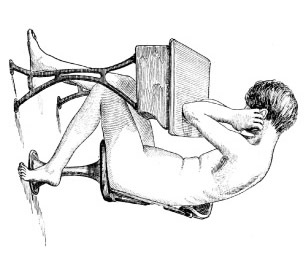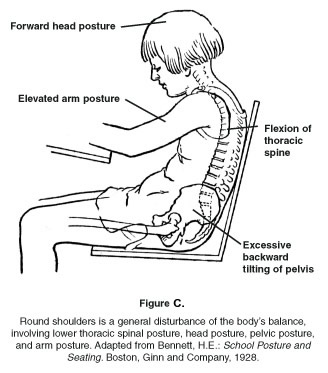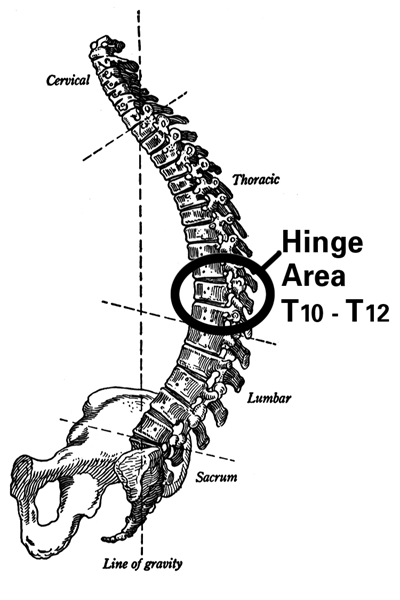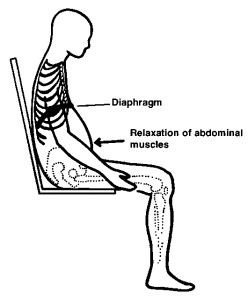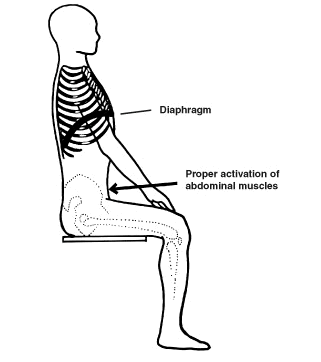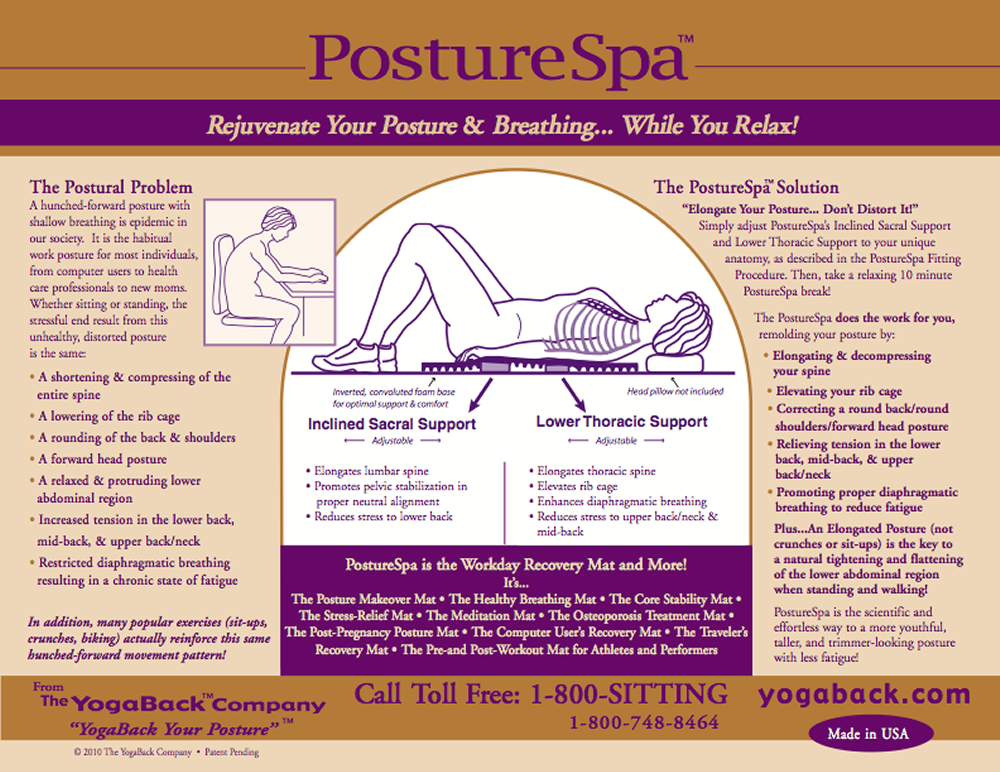 |
To reinforce your PostureSpa alignment, don't forget the YogaBack for Driving-- for effortless posture therapy during your daily commute. |
|
Convoluted Foam Base
Pads
Cover
Fitting Instructions Included Full 1-Year Warranty Made in USA
|
||||
|
Popular abdominal exercises such as crunches, sit-ups, and abdominal machines distort your posture by overdeveloping the upper abdominal region (the upper rectus abdominis muscle), while depressing the chest and rib cage, and rounding the upper back and shoulders. The end result: These exercises reinforce a slumped posture without correcting a protruding lower abdomen.
By rotating Figure A ninety degrees clockwise, this classic illustration from 1899 shows how the postural depression resulting from crunches, sit-ups, and abdominal machines (Figure B) is very similar to the postural depression in common sitting postures (Figure A). (From Bradford, E.H., and Stone, J.S.: The seating of school children. Transactions of the American Orthopaedic Association, 12:170-183, 1899.) In addition, expending continuous effort throughout the day to "hold the stomach in" mainly constricts the upper abdominal region, just below the ribs. This habitual constriction further weakens the lower abdominal region instead of flattening it, along with restricting proper diaphragmatic breathing. A tightening and flattening of the lower abdominal region occurs naturally and effortlessly when upright due to the activation of postural reflexes. The keys to activating these postural reflexes, all reinforced by relaxing on the PostureSpa, are as follows:
References Anderson, T. McC.: Human Kinetics and Analysing Body Movements. London, Heinemann, 1951. De Troyer, A.: Mechanical role of the abdominal muscles in relation to posture. Respiration Physiology, 53:341-353, 1983. Drew, L.C.: Individual Gymnastics, 5th ed. Philadelphia, Lea and Febiger, 1945. Floyd, W.F., and Silver, P.H.S.: Electromyographic study of patterns of activity of the anterior abdominal wall muscles in man. Journal of Anatomy, 84:132-145, 1950. Frost, L.H.: Individual structural differences in the orthopedic examination. Journal of Health and Physical Education, 9:90-93,122, 1938. Lipetz, S., and Gutin, B.: An electromyographic study of four abdominal exercises. Medicine and Science in Sports, 2:35-38, 1970. Sarti, M.A., Monfort, M., Fuster, M.A., and Villaplana, L.A.: Muscle activity in upper and lower rectus abdominis during abdominal exercises. Archives of Physical Medicine and Rehabilitation, 77:1293-1297, 1996. Wiles, P.: Postural deformities of the anteroposterior curves of the spine. The Lancet, 1:911-919, April 17, 1937. Zacharkow, D.: Posture: Sitting, Standing, Chair Design and Exercise. Springfield, Thomas, 1988. |
||||
Round Shoulders Misconceptions "Pull your shoulders back!" Most of us have heard that command at one time or another from a teacher, therapist, or parent. Strengthening the muscles between the shoulder blades to correct a round shoulders posture is an example of a segmental approach to posture that is also a misconception. A physical therapy study in 1990 did not support the prescription of muscle strengthening exercises to correct a round shoulders posture (DiVeta et al., 1990). A holistic approach to posture considers round shoulders to be a general disturbance of the body's balance. In the sitting position, lower thoracic spinal posture, pelvic posture, head posture, and arm posture are all interrelated to round shoulders (Figure C).
Therefore, round shoulders result from flexion of the lower thoracic spine, excessive forward or backward tilting of the pelvis, a reaching forward of the head, and a raising forward of the upper arms from their balanced vertical position at the sides of the hips. So, the bad news is that pulling the shoulders back when sitting or standing will not correct a round shoulders posture. Moreover, it will only result in a different postural deviation that distorts proper body alignment and fatigues the upper back! The good news is that by elevating the rib cage through the lower thoracic support, and stabilizing the pelvis in the proper neutral alignment through the inclined sacral support, the PostureSpa restores the proper alignment of the shoulders. References DiVeta, J., Walker, M.L., and Skibinski, B.: Relationship between performance of selected scapular muscles and scapular abduction in standing subjects. Physical Therapy, 70:470-479, 1990. Fahrner: Das Kind und der Schultisch. Zurich, Schulthess, 1865. Translated in Cohn, H.: The Hygiene of the Eye in Schools. London, Simpkin, Marshall and Co., 1886, pp. 94-98. Lovett, R.W.: Round shoulders and faulty attitude: a method of observation and record, with conclusions as to treatment. Boston Medical and Surgical Journal, 147:510-520, 1902. Sucher, B.M., and Heath, D.M.: Thoracic outlet syndrome—a myofascial variant: part three. Structural and postural considerations. The Journal of the American Osteopathic Association, 93:334, 340-345, 1993.
|
||||
|
PostureSpa's Adjustable Lower Thoracic Support corrects the main cause of a round back, round shoulders, and forward head posture-- the hinging forward and downward of the rib cage due to flexion of the lower thoracic spine.
PostureSpa's Lower Thoracic Support, adjustable to support any individual's T10 -T12 region...
The vast majority of individuals have never experienced the immediate and dramatic benefits of lying and sitting with an isolated lower thoracic support. Unfortunately, most individuals have been distorting their posture and breathing for years with lumbar support and/or upper thoracic support.
References Alexander, C.J.: Scheuermann’s disease. Skeletal Radiology, 1:209-221, 1977. Branton, P.: Backshapes of seated persons—how close can the interface be designed? Applied Ergonomics, 15:105-107, 1984. Decima, E.E., von Euler, C., and Thoden, U.: Intercostal-to-phrenic reflexes in the spinal cat. Acta Physiologica Scandinavica, 75:568-579, 1969. Humphry, G.M.: A Treatise on the Human Skeleton. Cambridge, MacMillan, 1858. Leanderson, R., Sundberg, J., and von Euler, C.: Role of diaphragmatic activity during singing: a study of transdiaphragmatic pressures. Journal of Applied Physiology, 62:259-270, 1987. Markolf, K.L.: Deformation of the thoracolumbar intervertebral joints in response to external loads. The Journal of Bone and Joint Surgery, 54-A:511-533, 1972. Remmers, J.E.: Extra-segmental reflexes derived from intercostal afferents: phrenic and laryngeal responses. Journal of Physiology, 233:45-62, 1973. Romaniuk, J.R., Supinski, G.S., and DiMarco, A.F.: Reflex control of diaphragm activation by thoracic afferents. Journal of Applied Physiology, 75:63-69, 1993. Vulcan, A.P., King, A.I., and Nakamura, G.S.: Effects of bending on the vertebral column during +Gz acceleration. Aerospace Medicine, 41:294-300, 1970. Wiles, P.: Postural deformities of the anteroposterior curves of the spine. The Lancet, 1:911-919, April 17, 1937. Zacharkow, D.: Posture: Sitting, Standing, Chair Design and Exercise. Springfield, Thomas, 1988.
|
||||
The Problems with Traditional Diaphragmatic Breathing
Expanding the lower abdomen at the start of inspiration relaxes the transversus abdominis (deep lower abdominals), resulting in a lowered position of the diaphragm and excessive shortening of the diaphragm (Figure E). This relaxation of the transversus abdominis also increases the compressive stress on the lower back.
PostureSpa and YogaBack breathing promote a spontaneous co-activation of the transversus abdominis and diaphragm. Activation of the transversus abdominis results in a raised position of the diaphragm at the start of inspiration (Figure F). As the diaphragm descends, the transversus abdominis optimizes diaphragmatic breathing by preventing excessive shortening of the diaphragmatic muscle fibers. This inspiratory transversus abdominis muscle activity also improves the diaphragm's ability to lift the lower ribs, thereby expanding the lower rib cage. This co-activation of the transversus abdominis and diaphragm reduces the fatigue and spinal compression from traditional diaphragmatic breathing. Learning this optimal diaphragmatic breathing technique is effortless with PostureSpa's Inclined Sacral Support and Lower Thoracic Support.
References
Bouisset, S., and Zattara, M.: A Sequence of postural movements precedes voluntary movement. Neuroscience Letters, 22:263-270, 1981. Bouisset, S., and Duchêne, J.-L.: Is body balance more perturbed by respiration in seating than in standing posture? NeuroReport, 5:957-960, 1994. Branton, P.: The Comfort of Easy Chairs. Stevenage, Hertfordshire, England, The Furniture Industry Research Association, 1966. Branton, P.: Behaviour, body mechanics and discomfort. In Grandjean, E. (Ed.): Proceedings of the Symposium on Sitting Posture. London, Taylor and Francis, 1969, pp. 202-213. Cutler, W.B., Friedmann, E., and Genovese-Stone, E.: Prevalence of kyphosis in a healthy sample of pre- and postmenopausal women. American Journal of Physical Medicine and Rehabilitation, 72:219-225, 1993. Decima, E.E., von Euler, C., and Thoden, U.: Intercostal-to-phrenic reflexes in the spinal cat. Acta Physiologica Scandinavica, 75:568-579, 1969. De Troyer, A.: Mechanical role of the abdominal muscles in relation to posture. Respiration Physiology, 53:341-353, 1983. Hodges, P. W., et al.: Contraction of the human diaphragm during rapid postural adjustments. Journal of Physiology, 505:539-548, 1997. Knudsen, K.A.: A Textbook of Gymnastics, vol. one. London, Churchill, 1947. Leanderson, R., Sundberg, J., and von Euler, C.: Role of diaphragmatic activity during singing: a study of transdiaphragmatic pressures. Journal of Applied Physiology, 62:259-270, 1987. O’Gorman, H., and Jull, G.: Thoracic kyphosis and mobility: the effect of age. Physiotherapy Practice, 3:154-162, 1987. O’Sullivan, P.B., et al.: The effect of different standing and sitting postures on trunk muscle activity in a pain-free population. Spine, 27:1238-1244, 2002. Sandover, J., and Dupuis, H.: A reanalysis of spinal motion during vibration. Ergonomics, 30:975-985, 1987. Xie, A., Takasaki, Y., Popkin, J., Orr, D., and Bradley, T.D.: Chemical and postural influence on scalene and diaphragmatic activation in humans. Journal of Applied Physiology, 70:658-664, 1991. Xie, A., Takasaki, Y., and Bradley, T.D.: Influence of body position on diaphragmatic and scalene activation during hypoxic rebreathing. Journal of Applied Physiology, 75:2234-2238, 1993. Zacharkow, D.: ZACKBACK Sitting. Rochester, ZACKBACK International, 1998. |
||||
FACT SHEET Women’s Epidemic Round Back Posture• Up to fifty-one percent of healthy women from ages twenty to sixty-four are kyphotic in their normal posture.(1) • Compared to younger and older age groups, the most dramatic decline in thoracic extension mobility occurs in women • Beyond approximately age forty, the rate of increase in thoracic kyphosis is much higher in women than men.(3) • An increased thoracic kyphosis occurs during pregnancy.(4) • An increased thoracic kyphosis is characteristic of women who habitually wear high-heeled shoes.(5) • An increased thoracic kyphosis is characteristic of women who overdevelop the upper rectus abdominis muscle with sit-ups • A woman’s breast development increases the forward bending moment on the thoracic spine via the rib cage. • A habitual postural kyphosis can play a role in bone remodeling among healthy premenopausal women.(1) • T11 and T12, the vertebrae located at the “hinge area” for spinal flexion, are the most frequently deformed vertebrae in postmenopausal women. (8) (This T11 - T12 spinal region is the exact location of the lower thoracic support with the PostureSpa, YogaBack for Driving and the ZACKBACK Posture Chair. As a result, the hinging forward and downward of the rib cage is prevented, correcting a round back/round shoulders posture.)
REFERENCES 1. Cutler, W.B., Friedmann, E., and Geneovese-Stone, E.: Prevalence of kyphosis in a healthy sample of pre- and postmenopausal women. 2. O’Gorman, H., and Jull, G.: Thoracic kyphosis and mobility: the effect of age. Physiotherapy Practice, 3:154-162, 1987. 3. Fon, G.T., Pitt, M.J., and Thies, A.C.: Thoracic kyphosis: range in normal subjects. American Journal of Roentgenology, 134:979-983, 1980. 4. Bullock, J.E., Jull, G.A., and Bullock, M.I.: The relationship of low back pain to postural changes during pregnancy. 5. Antioch College Studies: The Effects of Modern Shoes Upon Proper Body Mechanics. Yellow Springs, Antioch College, 1931. 6. Zacharkow, D.: Posture: Sitting, Standing, Chair Design and Exercise. Springfield, Thomas, 1988. 7. Zacharkow, D.: ZACKBACK Sitting. Rochester, ZACKBACK International, 1998. 8. Puche, R.C., et al.: The natural history of kyphosis in postmenopausal women. Bone, 17:239-246, 1995.
|
Site Content Copyright 2002-2025, The YogaBack Company, P.O. Box 9113, Rochester, MN 55903. 1-800-SITTING ( 1-800-748-8464 ) |
